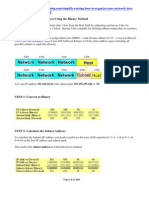Internship Wsu
Internship Wsu
Uploaded by
GEHAAD MEDIACopyright:
Available Formats
Internship Wsu
Internship Wsu
Uploaded by
GEHAAD MEDIACopyright
Available Formats
Share this document
Did you find this document useful?
Is this content inappropriate?
Copyright:
Available Formats
Internship Wsu
Internship Wsu
Uploaded by
GEHAAD MEDIACopyright:
Available Formats
COLLEGE OF INFORMATICS
DEPARTMENT OF COMPUTER SCIENCE AND ENGINEERING
INTERNSHIP AT WOLAITA SODO UNIVERSITY ICT DIRECTORATE
SUBMITTED TO THE DEPT. OF COMPUTER SCIENCE AND ENGINEERING
INTERNSHIP: NETWORK ENGINEERING
SUBMITTED BY: KAWOTO BOGALE (RU1848/12), YOHANIS ZEKARIAS (RU0932/12)
SUPERVISOR AT WSU ICT DIRECTORATE: MR. ABRAHAM
SUPERVISOR AT CAMPUS: MR. DERIBA
DURATION: NOV 13, 2023 - JAN 19, 2024
SUBMISSION DATE: 2/14/2024
02/21/2024 INTERNSHIP REPORT 1
CHAPTER ONE
INTRODUCTION
1, Historical Background and overviews
Wolaita Sodo University was established on 24 March 2007 by proclamation.
The university started its duty with 16 undergraduate programs and 807 students.
Now over 35,000 active students; until 2019 the university has graduated 57,188 students.
There are 1,626 Academic, and 3,770 Administrative staff.
It is approximately 339 kilometers(210.65 Miles) far from Addis Ababa, Ethiopian southwest
direction.
The university has three campuses: Gandaba Campus, Otona Campus, and Tercha Campus.
Wolayita Sodo University has 58 undergraduate programs, 43 postgraduate programs, 6 Doctor of
Philosophy programs, and 4 Medical specialty programs.
02/21/2024 INTERNSHIP REPORT 2
Mission of WSU ICT directory
The mission of the ICT Directorate is to play a major enabling role in strengthening the
operational missions of the University, namely learning-teaching, research and innovation,
community engagements, institutional development, and administration.
Vision of WSU ICT directory
One of the WSU ICT directory visions is to give an active network for WSU. As WSU know
they use old networking systems and wiring systems in the University. In case they plan to
change it in the coming years to HUAWEI, it is more advanced at this time.
02/21/2024 INTERNSHIP REPORT 3
Organizational Structure
Information and Communication Technology Directorate reports to the Office of the President as it is
responsible for the provision of ICT infrastructure, services, and systems for the four operational domains
of the University: Learning-teaching, research and innovation, community engagements, and governance
services.
The directorate’s governance structure embodies five operational units:
ICT Infrastructure and Services Unit
Business Applications Development and Administration Unit
Teaching-Learning Technologies Unit
ICT Support and Maintenance Unit
ICT Training and Consultancy Services Unit
02/21/2024 INTERNSHIP REPORT 4
Objectives
To apply our theoretical knowledge in practice, effectively solve networking-related
problems, and enhance our skills to benefit our future company.
General Objective
The main objective of this internship is Network Installation at the Wolayita Sodo
University ICT Center.
Specific Objective
To perform the objective of the field practice, the following specific activities are necessary to
perform the general objective of the study: -
To study the existing environment regarding Network Installation within the Wolayita Sodo
University ICT Center.
02/21/2024 INTERNSHIP REPORT 5
CHAPTER TWO
Work, Responsibilities and Assignments
We took our internship time at WSU in the Department of Information Communication Technology.
During our field Practice, we learned basic skills about networking and we observed the network
infrastructure in WSU.
We have used different materials related to network and network devices.
Tasks we have been executing
Task1: Cable crimping and arrangement
This is a basic and easy part of network installation and it is a part of different tasks in
networking. In this task, we practiced all three types of crimping cable and we familiarized
ourselves more because it comes in different aspects of networking
02/21/2024 INTERNSHIP REPORT 6
Cont…
Task2: How to configure switch
During our internship at Wolaita Sodo University, we learned how to configure network switches using
Cisco Packet Tracer. Switches connect computers in a network and help manage network traffic by
creating VLANs.
Figure3: Switch
02/21/2024 INTERNSHIP REPORT 7
Task 3: We observed the WSU data center
Wolayita Sodo University uses a hierarchical network design model, which uses a layered approach to
network design. The building block components are the access layer, the distribution layer, and the core
(backbone) layer.
The university decided to use a hierarchal networking design because of the following advantages
The network performance is very high.
Simple to network management and troubleshooting faults.
Troubleshooting is simple
Scalable and allows for easy expansion
The building blocks of modular networks are easy to replicate, redesign, and expand. There should be
no need to redesign the whole network each time a module is added or removed.
02/21/2024 INTERNSHIP REPORT 8
Figure: Hieratical Campus Network Design
02/21/2024 INTERNSHIP REPORT 9
A. Core Layer
The core layer is sometimes called the network backbone. Routers and switches at the core layer provide
high-speed connectivity. The core layer may connect multiple lines, fast and extremely resilient because
every building block depends on it for connectivity.
Figure: WSU data center structure
B. Distribution Layer
The distribution layer represents a routing boundary between the access layer and the core layer. It
also serves as a connection point between remote sites and the core layer.
02/21/2024 INTERNSHIP REPORT 10
C. Access Layer
The access layer is the first point of entry into the network for edge devices, end stations, and IP phones.
The access layer is used to control user access to the internetwork resources. The network designer has
to facilitate the traffic generated from the access layer as it is bound for other segments or other layers
within the network.
Core Switch
Core switches serve as the gateway to a wide area network (WAN) or the Internet - they provide the final
aggregation point for the network and allow multiple aggregation modules to work together.
Figure: Network distribution of WSU
02/21/2024 INTERNSHIP REPORT 11
What is a core switch used for?
The core switch is used to send data to the distribution switch and protects high collusion of data in
between distribution switches. It sends data by fiber optic cable.
A core switch has layers 3 capabilities and therefore does routing of packets like Routers within VLANS in a
campus LAN.
Figure: WSU Core switch
02/21/2024 INTERNSHIP REPORT 12
Distribution switch
A distribution switch is a distribution layer switch, which links to the upper layer core switch and links
down to the access/edge switch. Simply put, an aggregation switch in between functions is a bridge
between the core layer switch and the access layer switch.
Figure WSU09- Distribution switch
Access switch
An access switch allows users to connect to the network. On this account, the access switch is normally
endowed with the supportable features of port security, VLANs, Fast Ethernet/Gigabit Ethernet, etc
Access layer switches allow users to set the VLANs for the end node devices on the network.
02/21/2024 INTERNSHIP REPORT 13
CHAPTER THREE
3. Technical Aspect of the Internship
We have basic theoretical and practical knowledge about network and network materials such as:-
• Crimping network cable
• Network installation
• Wi-Fi Network Material/tools
• Network Infrastructure
• How to configure the switch and router
• Data Center
02/21/2024 INTERNSHIP REPORT 14
Methods and procedures
Methods or procedures we have seen in crimping UTP cables:
Prepare all the materials needed.
• Cut into the plastic sheath from the end of the cut cable.
• Unwind and pair similar colors.
• Pinch the wires between your fingers and straighten them out as shown. The color order is
important to get the correct
• Carefully push all 8 un-stripped colored wires into the RJ 45 connector.
• A view from the top: All the wires are all the way in. There are no short wires.
• Check the cable.
02/21/2024 INTERNSHIP REPORT 15
Methods or procedures we have seen in configuring the router:-
• Turn on the router.
• Connect your computer to the router.
• Launchawebbrowserandenterhtttp://tplinkwifi.net.
• Click next to start the quick setup.
• elect Access point and follow the step-by-step instruction of the Quick Setup to
set up the internet connection.
• Then press the finish button.
Methods or procedures we have seen in Access switch configuration:-
Switch in different mode depends on commands.
• Setting the Host name and Configure Console password.
• Create and Configure VLAN on the Access switch.
• Assign ports to different VLANS and Ethernet channel configurations.
• Then save and exit.
02/21/2024 INTERNSHIP REPORT 16
Technical tasks/products
Crimping network cables
A. Straight through Ethernet cables:- is the most common type and is used to connect different
network devices such as:-
• Computers to hubs or switch
• Switch to router
• Switch to server
Side One Side Two
1. White/Orange 1. White/Orange
2. Orange 2. Orange
3. White/Green 3. White/Green
4. Blue 4. Blue
5. White/Blue 5. White/Blue
6. Green 6. Green
7. White/Brown 7. White/Brown
8. Brown 8. Brown
Table: two endings of Straight through cable
02/21/2024 INTERNSHIP REPORT 17
How to make standard cable:-
Cut into the plastic sheath from Unwind and pair similar colors
the end of the cut cable
Figure12: unwind cable
Figure: Cut cable
02/21/2024 INTERNSHIP REPORT 18
• Pinch the wires between your fingers
• Carefully push all 8 un-stripped
and straighten them out as shown.
colored wires into the RJ 45
The color order is important to get
connector
correct.
Figure: Pinch the wire Figure14: push the cable
A view from the top: All the wires are
in. There are no short wires
Crimping the cable:
carefully place the connector into
the Ethernet Crimper and cinch
down on the handles tightly.
Then make sure to test cables
before installing them.
02/21/2024 INTERNSHIP REPORT 19
B. Crossover cable Ethernet cable
It is used to directly connect one computer to another computer without going
through a router, switch, or hub.
Is a type of Ethernet cable used to connect similar devices directly.
use two different wiring standards: one end uses the T568A wiring standard and the
other end-use T568B wiring standard
Side One Side Two
1-whiteorange 1-whitegreen
2-orange 2-green
3-whitegreen 3-whiteorange
4-blue 4-blue
5-whiteblue 5-whiteblue
6-green 6-orange
7-whitebrown 7-whitebrown
8-brown 8-brown
Table: two endings of crossover cable
02/21/2024 INTERNSHIP REPORT 20
C. Rollover Ethernet cable:-
Also known as Yost cable, Cisco cable, or console cable) is a type of null-modem cable that is used to connect
a computer terminal to a router’s console port.
Side One Side Two
1 white-orange 1.brown
2. orange 2.white- brown
3. white- green 3.green
4. blue 4.white -blue
5. white-blue 5.blue
6. green 6.white-green
7. white- brown 7.orange
8. Brown 8.white-orange
Table: two endings of rollover cable
Figure Rollover cable order
02/21/2024 INTERNSHIP REPORT 21
Network installation
At WSU we made one empty room as a computer lab through the process of
network installation and we got knowledge about how to install a network by using
different network devices such as switches, hubs, etc.
Network Node:- is a connection point or an endpoint for data transmissions.
Console Cable:- is used for connecting your computer's serial port to the RJ-45
console port on most Cisco equipment.
Puncher: A puncher is a device used to cut the insulation part of the cables and
put them in the hole of the ports or the socket (the one placed on the wall) as
well as cut down the extra length of the cables.
02/21/2024 INTERNSHIP REPORT 22
Header/data jack: is attached to the boxer face plate at the backside which is
used to terminate the UTP cat6 cable. Also for generating the UTP cat6 cable.
Screwdriver:- This tool is used to drive the bolt to in the trunk with the wall.
Cable trunk/Trucking: This is used to hold the cables together and pass along
the wall to transfer network cables to another place. The purpose of the trunk
is to prevent the Cat 6 UTP cable and fiber optic cable from being damaged.
Drill Machine: A drill machine used to drill the wall to connect the trunk and
node to the wall.
02/21/2024 INTERNSHIP REPORT 23
Knowledge and Acquaintances Acquired
In our entire internship, we gained very different knowledge and this
knowledge is helpful in our everyday lives. The following are the basic skills we
got from the full internship.
Technical Skills Gained
Configuring, managing, and maintaining networking equipment: Routers
and Switch
Instating, configuring, and administering network technologies
VLAN configuration
Basic skills such as: - crimping, drilling, cable trucking, etc.
02/21/2024 INTERNSHIP REPORT 24
Management Skills Gained
Plan and order the team
Inspiration of the group to perform the task effectively
Attending on time and being a model to others
Appreciating the team for their good work
Helping and showing the way to the when the team faces challenges.
Acquaintances Acquired
we have learned that it is how well you communicate with someone &
and how well you behave or carry yourself.
we had a good relationship with staff members which enabled us to ask
whatever questions we had.
02/21/2024 INTERNSHIP REPORT 25
Contributions
Some of our contributions are:
We played a crucial role in the installation of the network in the veterinary
block.
We checked three switches out of five that were not giving any.
We solved the problem related with networking cable and we fixed it.
These all are our basic contributions to the company, but not only have we
had also an important role in checking and solving problems in the
professionals' office when they call us or the supervisor orders us on the full
Wi-Fi installation in Techno Campus in WSU.
02/21/2024 INTERNSHIP REPORT 26
CHAPTER FOUR
4. General Comments and Conclusions
Problems Encountered During the Internship Period
Some of the challenges that we have faced during our field practices:
1. Material limitations at internship start.
2. Punctuality issue in field practice.
3. WSU ICT program division incomplete.
4. Employees not sharing talents.
5. Lack of technical support.
02/21/2024 INTERNSHIP REPORT 27
Measures taken to overcome the challenges
1. Proactive approach to address material limitations by requesting support
from the ICT director.
2. Implementation of a structured schedule for practical work over three
months to ensure completion of tasks.
3. Utilization of self-learning and reading to compensate for lack of technical
support.
4. Acquisition of valuable skills such as problem-solving, teamwork, hard
work, reading habits, and persistence through the internship experience.
02/21/2024 INTERNSHIP REPORT 28
General Suggestions and Comments to the Company
The basic idea we considered and we want to suggest to the company is that
the network topology is random and it should be organized in a modern way,
this is used to control the overall network simply.
Summary and Conclusion
In conclusion, our internship experience at WSU has been invaluable in
providing us with practical knowledge and skills in configuring network tools
such as switches and routers, as well as installing networks through tasks
like drilling, crimping, and VLAN configurations.
We are grateful to WSU and our university, BHU, for the opportunity to
deepen our understanding of network installation and for their support
throughout our internship.
This experience has been a pivotal moment in our lives, equipping us with
essential skills that will serve us well in our future careers.
02/21/2024 INTERNSHIP REPORT 29
Recommendations
Foster positive & supportive environment for students
- Address prevalent negative staff attitude
- Support student learning in maintenance & system development
- Encourage positive approach towards students
- Showcase student skills & support development
- Students play significant role in country's progress
02/21/2024 INTERNSHIP REPORT 30
You might also like
- Hostel Management Project Report CTP 6077Document51 pagesHostel Management Project Report CTP 6077David LwangaNo ratings yet
- Campus Network Design v2.0Document55 pagesCampus Network Design v2.0agaver2No ratings yet
- Complete Library Management System Project ReportDocument79 pagesComplete Library Management System Project ReportManoj instituteNo ratings yet
- Literature Review Cloud ComputingDocument3 pagesLiterature Review Cloud ComputingFarhan Sarwar100% (1)
- Advantages of RMIDocument2 pagesAdvantages of RMIRASHMI DABRENo ratings yet
- Online Bus Ticket Reservation SystemDocument18 pagesOnline Bus Ticket Reservation SystemChakku ParuNo ratings yet
- Concurency Control FullDocument18 pagesConcurency Control Fullgopi9966957145No ratings yet
- Synopsis of Online Task Management SystemDocument4 pagesSynopsis of Online Task Management SystemNawalKSahNo ratings yet
- Collage Management SystemDocument7 pagesCollage Management System28bhavik1992No ratings yet
- 3 Driving License ManagementDocument7 pages3 Driving License ManagementTamiru DerejeNo ratings yet
- Objective of Online Notice Board ProjectDocument2 pagesObjective of Online Notice Board ProjectRajes KumarNo ratings yet
- Projectreport 121202043850 Phpapp02Document120 pagesProjectreport 121202043850 Phpapp02Narayan LokeNo ratings yet
- JIJIN JACOB - Final Project Report - AnimZ JuggernautDocument35 pagesJIJIN JACOB - Final Project Report - AnimZ JuggernautOnyekachi AkanoNo ratings yet
- Employee Leave Management System Project ReportDocument91 pagesEmployee Leave Management System Project Report007Ãrnav SinghaNo ratings yet
- Attendance Management Using AWS Cloud: AbstractDocument7 pagesAttendance Management Using AWS Cloud: AbstractBeckyNo ratings yet
- A SEMINAR REPORT Tele-Immersion 1gowDocument25 pagesA SEMINAR REPORT Tele-Immersion 1gowSunil RAYALASEEMA GRAPHICSNo ratings yet
- Laundry Management SystemDocument34 pagesLaundry Management SystemTalHa IFtiKharNo ratings yet
- Project Online Mobile Recharge SystemDocument10 pagesProject Online Mobile Recharge SystemJatin Sharma100% (2)
- TEACHING AND EVALUATION SCHEME FOR 5th Semester (CSE) (Wef 2020-21)Document25 pagesTEACHING AND EVALUATION SCHEME FOR 5th Semester (CSE) (Wef 2020-21)Bibhu Dutta MahapatraNo ratings yet
- Wired Lans: Ethernet: Mcgraw-HillDocument41 pagesWired Lans: Ethernet: Mcgraw-Hillprince keshriNo ratings yet
- Multi Touch Screen Technology: Seminar ofDocument25 pagesMulti Touch Screen Technology: Seminar ofgopyaleNo ratings yet
- LibraryDocument217 pagesLibraryAvinash SinghNo ratings yet
- The Project Documentation of Telephone Billing SystemDocument78 pagesThe Project Documentation of Telephone Billing Systemdeep2550% (1)
- Synopsis Report On Mail ServerDocument7 pagesSynopsis Report On Mail ServerNitish_Gupta_688050% (4)
- Design and Implementation of Integrated Mobile Responsive Student Enrolment SystemDocument9 pagesDesign and Implementation of Integrated Mobile Responsive Student Enrolment SystemDIANA MALABAONo ratings yet
- Hospital Management System (Documentation)Document35 pagesHospital Management System (Documentation)harsh1412nNo ratings yet
- Project Synopsis Format 2019Document6 pagesProject Synopsis Format 2019Amitoz singhNo ratings yet
- Chapter One (History and Overview)Document36 pagesChapter One (History and Overview)mesfinNo ratings yet
- Student Result Processing SystemDocument19 pagesStudent Result Processing SystemCrystal MaidenNo ratings yet
- Project Report Online Library Management SystemDocument18 pagesProject Report Online Library Management SystemVijith ChissNo ratings yet
- Crime File MGMT ProjectDocument153 pagesCrime File MGMT Projectsunsrinivas83% (6)
- Bachelor in Computer Application: Online Notice Board SystemDocument16 pagesBachelor in Computer Application: Online Notice Board SystemSxtha BishanNo ratings yet
- College Information System BcaDocument91 pagesCollege Information System BcaPrints BindingsNo ratings yet
- SRS-Senior ProjectDocument37 pagesSRS-Senior ProjectRaging AuntyNo ratings yet
- WAPDocument23 pagesWAPDhruviNo ratings yet
- SRS Document For VTOP QueryDocument11 pagesSRS Document For VTOP QueryAyanNo ratings yet
- Attendance System For Students of Government-Aided SchoolsDocument8 pagesAttendance System For Students of Government-Aided SchoolsIJRASETPublicationsNo ratings yet
- Dbms Project On Bus Reservation System Last ReportdocxDocument13 pagesDbms Project On Bus Reservation System Last ReportdocxUrja DhabardeNo ratings yet
- Direct Internet Access SystemDocument7 pagesDirect Internet Access SystemKumar KksNo ratings yet
- Project On Web DevelopmentDocument13 pagesProject On Web DevelopmentArnav LekharaNo ratings yet
- SamiDocument35 pagesSamibehailumerete12No ratings yet
- FINAL DocumentationDocument91 pagesFINAL DocumentationHarshad Gaikwad46% (13)
- Cloud Based Blood Bank System - G83Document18 pagesCloud Based Blood Bank System - G83Kunal GadeNo ratings yet
- Last SubmissionDocument106 pagesLast SubmissionSalih AnwarNo ratings yet
- EmployeeDocument5 pagesEmployeelimenihNo ratings yet
- Data Flow Diagram MusicDocument12 pagesData Flow Diagram MusicSanjeevan AthinarayananNo ratings yet
- CB 17 Black BookDocument47 pagesCB 17 Black BookSonali KhaireNo ratings yet
- A Project Report ON: "Deparmental Storage Management System "Document19 pagesA Project Report ON: "Deparmental Storage Management System "manhar pratapNo ratings yet
- List of Computer Science Project TopicsDocument3 pagesList of Computer Science Project TopicsMangesh Kherdekar100% (1)
- Synopsis On NCC Management SystemDocument6 pagesSynopsis On NCC Management Systemarun kaushikNo ratings yet
- Bank Management SystemDocument63 pagesBank Management SystemAbhishek100% (1)
- Collaborative File Sharing System Phase IDocument29 pagesCollaborative File Sharing System Phase IfaizajeeNo ratings yet
- College Connect AppDocument20 pagesCollege Connect AppKeerthi0% (1)
- Hostel Management SystemDocument6 pagesHostel Management SystemVijayantPandaNo ratings yet
- Study On E-Waste Management MethodologyDocument5 pagesStudy On E-Waste Management MethodologyIJRASETPublicationsNo ratings yet
- Chapter 01Document13 pagesChapter 01ImranNo ratings yet
- House Hold ServiceDocument32 pagesHouse Hold Servicehackney cab bookingNo ratings yet
- Network Management System A Complete Guide - 2020 EditionFrom EverandNetwork Management System A Complete Guide - 2020 EditionRating: 5 out of 5 stars5/5 (1)
- Sub Netting de Diferentes ManerasDocument134 pagesSub Netting de Diferentes ManerasAntonio TebasNo ratings yet
- MCQ, Saq, Laq InfosecDocument53 pagesMCQ, Saq, Laq InfosecSoham ThakerNo ratings yet
- 90DTM6000 TD ENG v01 PDFDocument2 pages90DTM6000 TD ENG v01 PDFRaffi AfnanNo ratings yet
- Idp Configuration ExampleDocument21 pagesIdp Configuration ExamplehappynldaysNo ratings yet
- Medium Access Control: - MAC Belongs To Data Link Control LayerDocument7 pagesMedium Access Control: - MAC Belongs To Data Link Control LayerPraveen YadavNo ratings yet
- Wi-Fi Router Location - 802.11 CoverageDocument7 pagesWi-Fi Router Location - 802.11 CoveragePhoenix Liebe JeffNo ratings yet
- IoT ProtocolsDocument10 pagesIoT ProtocolsMushfiq ShahedNo ratings yet
- Cisco - SD-WAN-Policy Guide-Hub&SpokeTopology-v1Document34 pagesCisco - SD-WAN-Policy Guide-Hub&SpokeTopology-v1Craig CartlidgeNo ratings yet
- PayloadsDocument2 pagesPayloadsramariel240% (1)
- 3DM-GX4-25 Data Communications ProtocolDocument121 pages3DM-GX4-25 Data Communications ProtocolJose RamonNo ratings yet
- 08 ZMCDocument41 pages08 ZMCmscNo ratings yet
- Feature List of Huawei UMTS RAN11.0 V1.7 (20090331)Document14 pagesFeature List of Huawei UMTS RAN11.0 V1.7 (20090331)EmreNo ratings yet
- Configuring Ieee 802 1x Port Based AuthenticationDocument84 pagesConfiguring Ieee 802 1x Port Based Authenticationgjump0103No ratings yet
- SDWAN (Software Defined-WAN) Technology Evaluation and ImplementationDocument17 pagesSDWAN (Software Defined-WAN) Technology Evaluation and ImplementationWasayefNo ratings yet
- Debug 1214Document3 pagesDebug 1214Hapizz AsadNo ratings yet
- Elementary TCP SocketDocument17 pagesElementary TCP SocketNaveed Akbar MughalNo ratings yet
- SinoV-TE110E-B 1 E1 Asterisk Card For 2U Classis HighDocument4 pagesSinoV-TE110E-B 1 E1 Asterisk Card For 2U Classis HighCherry JiangNo ratings yet
- DGS-1510 Series CLI Reference Guide v1.70Document815 pagesDGS-1510 Series CLI Reference Guide v1.70Silvestre PerezNo ratings yet
- Chapter5 NetworkLayer, Part1Document73 pagesChapter5 NetworkLayer, Part1Dwayne HerryNo ratings yet
- Chapter 8 Lab CiscoDocument13 pagesChapter 8 Lab CiscoKarlo HernandezNo ratings yet
- Black Box Optinet Content FilteringDocument8 pagesBlack Box Optinet Content Filteringrodrigo.filgueiraNo ratings yet
- Zosilňovač WiFi Signálu 300M Emgo U25 NávodDocument48 pagesZosilňovač WiFi Signálu 300M Emgo U25 NávodVladimir RaščaninNo ratings yet
- Wire SharkDocument11 pagesWire SharkAnis Farhana AlimanNo ratings yet
- Moxa Etherdevice™ Switch: Eds-516A Series Hardware Installation GuideDocument15 pagesMoxa Etherdevice™ Switch: Eds-516A Series Hardware Installation GuideAkifNo ratings yet
- Umaru Saleh ReportDocument28 pagesUmaru Saleh ReportYAKUBU JOY ALLU100% (1)
- IEC 61850 Station Bus TopologiesDocument8 pagesIEC 61850 Station Bus TopologiesMaianh TranNo ratings yet
- SIP Errors 4xxDocument5 pagesSIP Errors 4xxbeleNo ratings yet
- 12 2 TelephonyDocument13 pages12 2 TelephonyAlbert MusabyimanaNo ratings yet
- TUDA1 User ManualDocument177 pagesTUDA1 User Manualebg72900No ratings yet

























































































